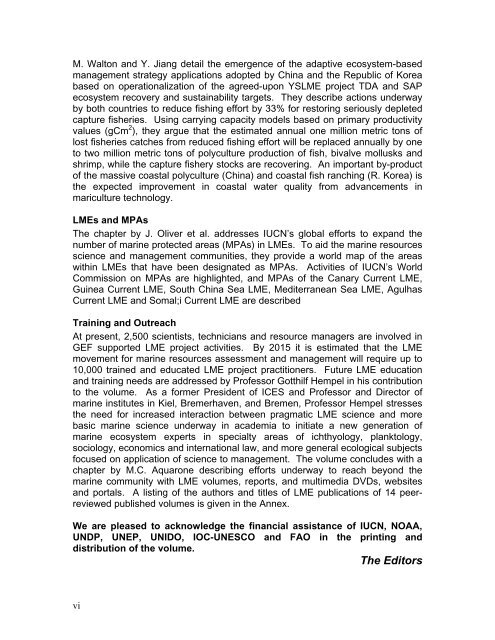Sustaining the World's Large Marine Ecosystems
Sustaining the World's Large Marine Ecosystems
Sustaining the World's Large Marine Ecosystems
You also want an ePaper? Increase the reach of your titles
YUMPU automatically turns print PDFs into web optimized ePapers that Google loves.
M. Walton and Y. Jiang detail <strong>the</strong> emergence of <strong>the</strong> adaptive ecosystem-based<br />
management strategy applications adopted by China and <strong>the</strong> Republic of Korea<br />
based on operationalization of <strong>the</strong> agreed-upon YSLME project TDA and SAP<br />
ecosystem recovery and sustainability targets. They describe actions underway<br />
by both countries to reduce fishing effort by 33% for restoring seriously depleted<br />
capture fisheries. Using carrying capacity models based on primary productivity<br />
values (gCm 2 ), <strong>the</strong>y argue that <strong>the</strong> estimated annual one million metric tons of<br />
lost fisheries catches from reduced fishing effort will be replaced annually by one<br />
to two million metric tons of polyculture production of fish, bivalve mollusks and<br />
shrimp, while <strong>the</strong> capture fishery stocks are recovering. An important by-product<br />
of <strong>the</strong> massive coastal polyculture (China) and coastal fish ranching (R. Korea) is<br />
<strong>the</strong> expected improvement in coastal water quality from advancements in<br />
mariculture technology.<br />
LMEs and MPAs<br />
The chapter by J. Oliver et al. addresses IUCN’s global efforts to expand <strong>the</strong><br />
number of marine protected areas (MPAs) in LMEs. To aid <strong>the</strong> marine resources<br />
science and management communities, <strong>the</strong>y provide a world map of <strong>the</strong> areas<br />
within LMEs that have been designated as MPAs. Activities of IUCN’s World<br />
Commission on MPAs are highlighted, and MPAs of <strong>the</strong> Canary Current LME,<br />
Guinea Current LME, South China Sea LME, Mediterranean Sea LME, Agulhas<br />
Current LME and Somal;i Current LME are described<br />
Training and Outreach<br />
At present, 2,500 scientists, technicians and resource managers are involved in<br />
GEF supported LME project activities. By 2015 it is estimated that <strong>the</strong> LME<br />
movement for marine resources assessment and management will require up to<br />
10,000 trained and educated LME project practitioners. Future LME education<br />
and training needs are addressed by Professor Gotthilf Hempel in his contribution<br />
to <strong>the</strong> volume. As a former President of ICES and Professor and Director of<br />
marine institutes in Kiel, Bremerhaven, and Bremen, Professor Hempel stresses<br />
<strong>the</strong> need for increased interaction between pragmatic LME science and more<br />
basic marine science underway in academia to initiate a new generation of<br />
marine ecosystem experts in specialty areas of ichthyology, planktology,<br />
sociology, economics and international law, and more general ecological subjects<br />
focused on application of science to management. The volume concludes with a<br />
chapter by M.C. Aquarone describing efforts underway to reach beyond <strong>the</strong><br />
marine community with LME volumes, reports, and multimedia DVDs, websites<br />
and portals. A listing of <strong>the</strong> authors and titles of LME publications of 14 peerreviewed<br />
published volumes is given in <strong>the</strong> Annex.<br />
We are pleased to acknowledge <strong>the</strong> financial assistance of IUCN, NOAA,<br />
UNDP, UNEP, UNIDO, IOC-UNESCO and FAO in <strong>the</strong> printing and<br />
distribution of <strong>the</strong> volume.<br />
The Editors<br />
vi









